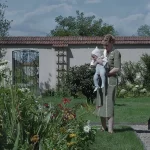A Different Kind of Horror, by Daniel Bergamini
There are a handful of genre filmmakers who consistently produce good films which year after year are ignored by mainstream audiences; one such director is Christopher Smith. Smith’s last film, Triangle, was a great piece of existential horror, which was ignored due to its similarities to Time Crimes. History seems to be repeating itself as Smith’s latest film, Black Death, is not receiving the attention it deserves.
Set during the 14th century in medieval England, the film follows a group of soldiers and a young monk as they travel to a small village, rumoured to be safe from the black plague. Osmund, the young monk, played by Eddie Redmayne, is torn between the love of a woman and his devotion to God. As he decides to set out with a group of soldiers in hopes to meet his love once again and find Divine guidance, his faith is tested once the soldiers reach the village.
The group is led by Ulric, a fundamentalist soldier played by the fantastic Sean Bean, whose belief in God and the devil drive him to rid the world of witches, necromancers and demons.
While both Bean’s and Redmayne’s performances seem monochromatic at first over the course of the film this changes completely and they deliver powerful performances.
Throughout his quest, Ulric does not change, his misguided devotion to ridding the world of the devil is as disturbing as it is unrelenting. When we first meet Osmund, we see a naive and innocent monk, who has remained largely isolated from the outside world. The film’s real focus is on the great change that Osmund experiences moving from good to evil. Often films which attempt to portray characters turning from good to evil will come off as forced and unrealistic, however the change that takes place in Black Death is disturbingly real and makes the film.
Smith’s use of the small budget is fantastic, as the low budget nature of the film does not show itself once. Without any bad CGI to cheapen the realism of the film, this picture feels more like a 70s film than a contemporary low budget period film. This is the kind of film that makes you feel dirty as every character, every street and brick looks as if it has not seen water in weeks. The villages and towns do not look like sets, they look lived in and this lends to the dirty, gritty feel of the film. While Smith’s consistent use of handheld cameras remains in line with the gritty, realistic feel of the film, it also detracts from the scale of the film. The camera is never too shaky, rather the large scale of the film is almost made smaller by the fact the shooting style seems so modern.
The film’s faults remain largely in the pacing, as the film is too short. Without the epilogue, the film would have been a solid effort, however as the last five minutes show us the consequences that the journey had on Osmund, we see an aspect of the film which deserves more time. The epilogue of the film, while lasting less than five minutes, adds an unexpected weight to the film. It takes a good film and adds an aspect which begs to be developed further.
While the film may be labeled an horror film, it would not be wise to think it is one while watching. The film shows a horrific period in human history, and does not shy away from the worst aspects of that time. It is a horror film in the truest sense of the word, but it is not what you come to expect from the genre. I have no doubt this film will be ignored, however this is one film which should not be. Smith is a filmmaker who has yet to have a true hit, however if he continues to produce great films like he has been for the last six years, it is just a matter of time.






























I’ve been interested in his work ever since I saw Severance. I thought Triangle was pretty great and am looking forward to seeing this.